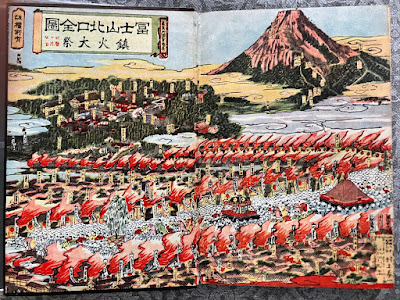Among the many foreigners to fall under Mt Fuji's spell, Frederick Starr (1858–1933) may have been the most enigmatic. Starr was a lecturer and professor at the University of Chicago for more than thirty years.
 |
| Frederick Starr |
During subsequent Japan trips, Starr started collecting charms (ofuda) and votive slips (senjafuda or nōsatsu). This earned him the nickname of Ofuda-Hakase (お札博士). It also led him to Mt Fuji. He walked around its foot in 1913, climbed to the summit in 1917 and 1919, and in the same year walked the Ochūdo-meguri – all this in the cotton robes of a pilgrim.
In 1924, Starr published his book, Fujiyama: The Sacred Mountain of Japan – even now, this is one of the few full-length books about Mt Fuji by a foreign author. In the frontispiece photo, we see him with Shibata Reiichi (1840–1920), the twelfth leader of Shintō Jikkōkyō, a Fuji-centred sect which traces its origins back to Fujidō, founded by Hasegawa Kakugyō (1541–1646).
In 1924, Starr published his book, Fujiyama: The Sacred Mountain of Japan – even now, this is one of the few full-length books about Mt Fuji by a foreign author. In the frontispiece photo, we see him with Shibata Reiichi (1840–1920), the twelfth leader of Shintō Jikkōkyō, a Fuji-centred sect which traces its origins back to Fujidō, founded by Hasegawa Kakugyō (1541–1646).
 |
| Frederick Starr with Shibata Reiichi. Illustration from Fujiyama. |
This suggests that Starr went to considerable efforts to research his book, which aimed to reveal “an attitude of mind” towards Mt Fuji and perhaps all sacred mountains. But the book is dedicated not to Shibata but to Sogabe Ikko.
 |
| Portrait of Sogabe Ikko. Illustration from Fujiyama. |
Sogabe had guided Starr on all his ascents of Mt Fuji – the two had met at a study group, the Nōsatsu-kai. Sogabe loved Mt Fuji and had climbed it almost a hundred times, we are told, and he probably provided Starr with some of his more unique material. Sogabe had started writing his own book on Mt Fuji in 1919, with a view to summing up his lifelong researches into the mountain.
 |
| "Lake Gamanaka (sic) seen through the rift in clouds". Illustration and original caption from Fujiyama. |
Sogabe was generous with this knowledge. On August 31, 1923 he called on Starr, saying that he would like to show his manuscript to Starr. They agreed to meet again a month later and spend the whole day poring over Sogabe’s manuscript.
That meeting never took place: on September 1, the great earthquake destroyed Sogabe’s house along with most of Tokyo and Yokohama. Sogabe was burned to death while trying to rescue his manuscript from the fire that ensued.
 |
| Monument to Frederick Starr, Mt Fuji Subashiri Route. |
Starr survived the earthquake, his hotel in Yokohama having survived the initial shock, and lived on until 1933. There is a monument to him above the Sengen Shrine on the Mt Fuji Subashiri route. Yet so many questions remain unanswered. Who was Sogabe? What kind of a book was he trying to write? And should we see Fujiyama as an attempt by Starr to rescue something of Sogabe's legacy?
 |
| Endpapers of Frederick Starr's Fujiyama. |
2 comments:
PH, thank you for another fascinating dive into these early foreign explorers of Japan’s mountains. I had a quick look to see if a PDF copy of Frederick Starr’s seminal text on Mt. Fuji might be available but couldn’t find one. His bond with Sogabe Ikko was clearly strong, and what a terrible loss it must have been – for Starr, losing his close friend and never seeing Sogabe-san’s manuscript. I also read that Starr collected not only religious artifacts but also a large number of Japanese and Korean toys, which, during the Taisho period, were apparently regarded less as children’s playthings and more as cultural artifacts by the well-to-do. Starr must have made quite an impression during his years in Japan – so much so that the Japanese prime minister attended his funeral.
Good evening, David, and thanks for reading - also for the nugget, new to me, that the PM attended his funeral. Indeed, a remarkable honour. If you want to take a deeper dive into Fujiyama, and the book is still well worth reading, there is an online text here:
https://babel.hathitrust.org/cgi/pt?id=uc1.$b53717&seq=7
Original editions are hard to find - I'm told that the nearest library copy for me is five hours away by train, at the Sorbonne in Paris. But surely some Tokyo library would have a copy. The book raises as many questions as it answers - for example, Starr says he made all his visits to Mt Fuji in a traditional pilgrim's garb - surely unusual for a foreigner in those days - but he doesn't say why. Mysteries, mysteries ...
Post a Comment